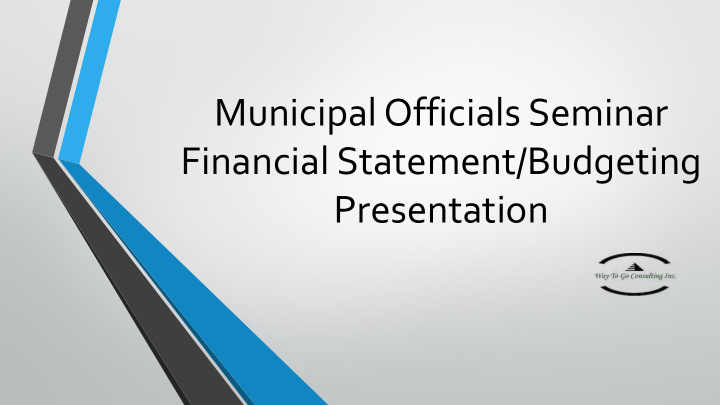



Municipal Officials Seminar Financial Statement/Budgeting Presentation
Topics • Audit, Auditors, Responsibility for Audit • Audited Financial Statements • Surplus • Asset Management Plans • Financial Plan – budgeting
Responsibility for Audited Financial Statements • Responsibility for preparation of audited financial statements is municipality’s, however in Manitoba, outside Winnipeg and Brandon, financial statements are prepared by the auditors • Auditors responsibility is to ensure that the audited Financial Statements accurately represent the financial status of the municipality and that there are no material misstatements • Audited financial statements have two letters or reports at the start of the statements; Statement of Responsibility and Independent Auditor’s Report
Management’s Responsibility • Management is responsible for the preparation and fair presentation of these consolidated financial statements in accordance with Canadian Public Sector Accounting Standards, and for such internal control as management determines are necessary to enable the preparation of financial statements that are free from material misstatements, whether due to fraud or error.
Auditor’s Opinion • In our opinion, the consolidated financial statements present fairly, in all material respects, the financial position of the ______ Municipality as at _____, and the result of its operations, change in net financial assets, and cash flows for the year ended _______ in accordance with the Canadian Public Sector Accounting Standards.
Selection of Auditors • Selection; RFP; same as lawyer, engineer, architect; some sort of basis besides lowest price • Province used to appoint; prices higher, more standardized auditing; presentation to Council
Assessment per Capita - 2012 46,287 42,335 41,211 37,229 35,551 30,910 28,295 Steinbach Brandon Winkler Selkirk Morden Portage la Prairie Dauphin
Surplus • For General Operating Fund; Municipal Act; Regulation 49/97; maximum amount that a council may transfer from accumulated surplus and general reserve is 20% of expenditures (excluding education requisitions) • For Utility Operating Fund, Public Utilities Board has a Working Capital calculation that determines Utility’s surplus: which must be greater than 20% of operating expenses: • Utility Fund Surplus • Less Tangible Capital Assets • Add Long Term Debt • Add Utility Reserves
Nominal Surplus and PSAB • Pre-PSAB, Municipalities had a Nominal Surplus account in General and Utility Funds. Nominal Surplus was in effect prior year’s operating surpluses that were available to spend. • For PSAB there is a Nominal Surplus note, usually 18 or 19, that shows the General Operating Fund Nominal Surplus.
What does this all mean (and who cares?) • For your General Operating Fund, it is worth looking at your Nominal Surplus balance, because you may have excess funds sitting there that are available for General Fund capital projects • For your Utility Operating Fund, the PUB uses working capital as part of their rate setting methodology (and because of the requirement to include amortization expense, as Working Capital grows, there should be funding available for capital projects).
Asset Management Plans • Federal 2013 budget stated “to maximize the value and ensure the sustainability of investments in our public infrastructure, the Government encourages all jurisdictions to undertake life-cycle cost assessments and develop robust capital asset management plans ”. • Infrastructure Canada, October, 2013 Presentation to Asset Management Workshop: • “Asset Management specific objective for renewed Gas Tax Fund:….Supporting and encouraging long- term municipal planning and asset management.” “Next Steps: Develop asset management requirements specific to each GTF Agreement”
Asset Management Plans continued • At present it appears that Asset Management Plans are required to be in place by 2018. • Ontario requires municipalities to have Asset Management Plans as a prerequisite to access Infrastructure funding. • Asset Management Plans are your 5 year capital plan on steroids with a lot more bells and whistles.
What is an Asset Management Plan • The Province of Ontario in the Ontario Asset management Plan Guide states: “Asset management requires a thorough understanding of the characteristics and condition of infrastructure assets, as well as the service levels expected from them. It also involves setting strategic priorities to optimize decision-making about when and how to proceed with investments. Finally, it requires the development of a financial plan, which is the most critical step in putting the plan into action.”
Components of an Asset Management Plan • An evaluation of the state of local infrastructure • A determination of the expected levels of service • The creation of an asset management strategy • A financing strategy
Budgeting • Incremental budgeting; almost all munis do this • Envelope budgeting • ZBB • Program budgeting
Financial Plan • In the Financial Plan, Council is used to looking at last year budgeted, last year (and maybe 2 years ago) actual and then ascertaining what should be budgeted for the upcoming year. Incremental budgeting. • There should be some emphasis, especially with the larger municipalities, to some sort of program budgeting approach. To look at the cost for various programs in total as opposed to line by line budgeting.
Financial Plan Continued • The 5 year capital plan is going to have to be expanded and lengthened in response to the upcoming requirement for asset management plans
Recommend
More recommend